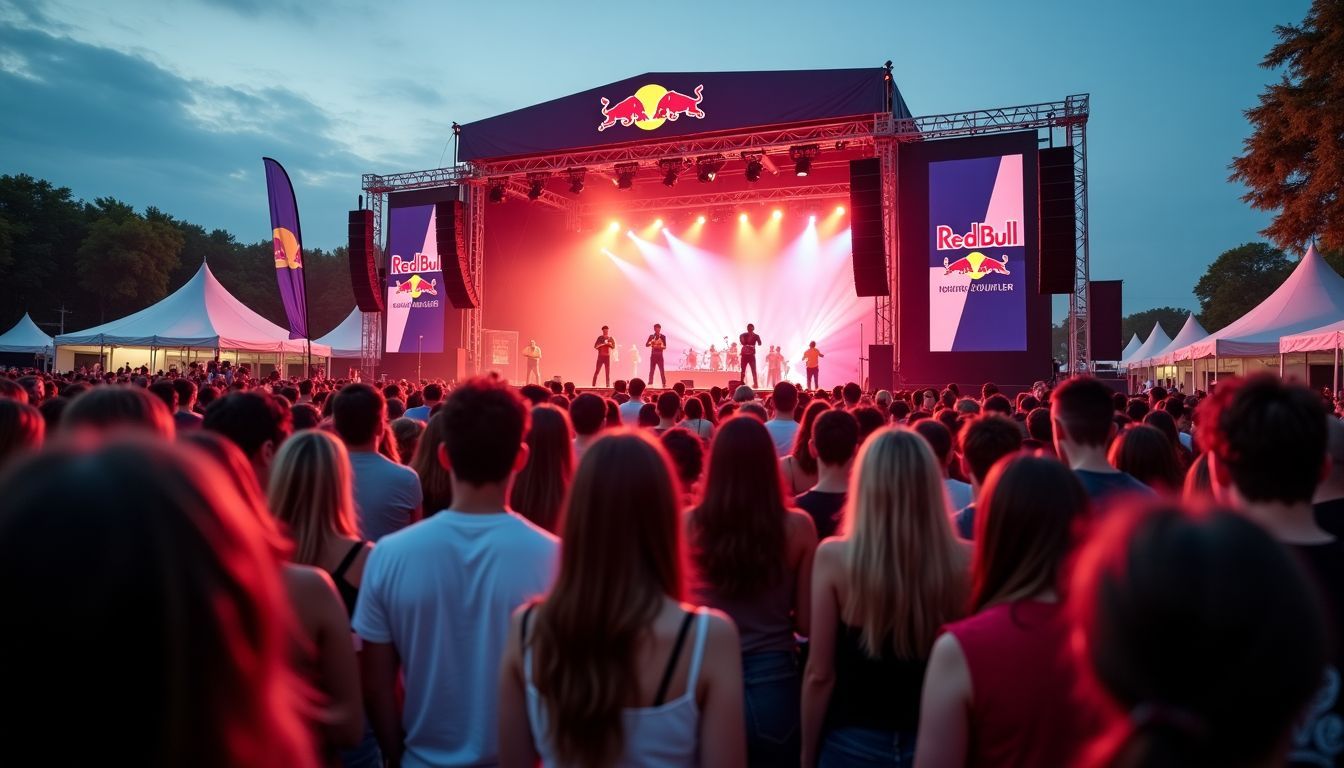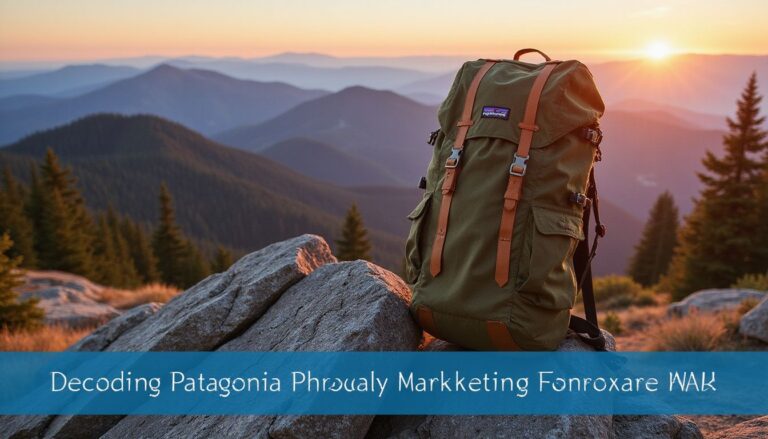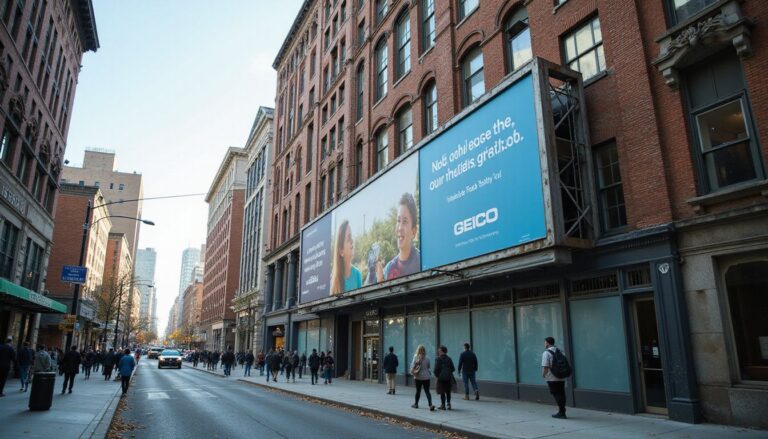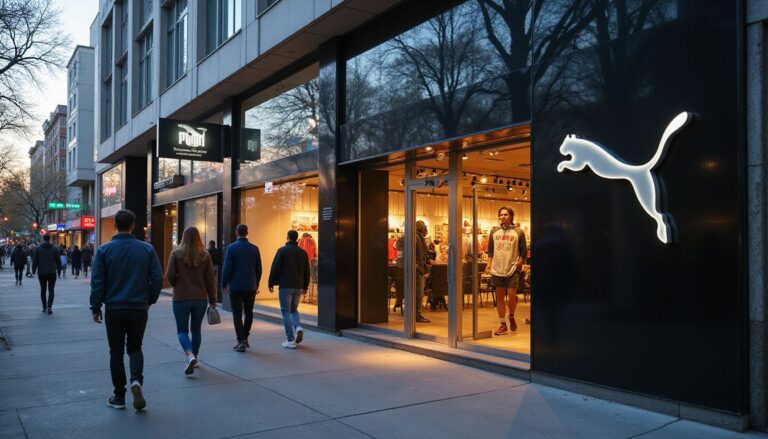Do you feel stuck trying to make your brand stand out in today’s crowded market? I struggled with this too, until I noticed something interesting: Red Bull uses smart marketing strategies to move beyond just an energy drink into a global lifestyle brand. 2 In this post, I’ll share clear lessons from Red Bull that can help you create strong campaigns and better reach the people you’re aiming for. 3 You don’t want to miss these insights! 1
Key Takeaways
- Red Bull reaches over 175 countries—selling 7.9 billion cans in 2020 alone—showing huge global appeal.
- They mostly target young adults (15-45 years old), especially men (70% of steady buyers), who love action sports and excitement.
- In 2012, Felix Baumgartner’s jump from 128,000 feet broke two world records, grabbing worldwide headlines for the brand.
- The Red Bull Media House creates content focused less on selling drinks, more on building brand identity—like their magazine, which pulls in 2.2 million readers every month.
- Red Bull also owns top sports teams—including Formula 1’s Red Bull Racing and soccer’s RB Leipzig—keeping the name front and center at major sports events.
Red Bull’s Marketing Strategy

Red Bull broke all the rules with a bold plan that changed how brands talk to fans. They skipped TV ads and went straight to where the action is – sports events, music shows, and wild stunts that get people talking.
Expanding into new markets
I’ve noticed global growth is central to Red Bull’s strategy. Today, the company sells energy drinks in over 175 countries. 2 That impressive reach wasn’t just luck—it came from careful planning.
Red Bull studies new markets closely, paying attention to local tastes and habits. Then, it shapes a smart approach tailored for each area.
To succeed in these fresh markets, Red Bull uses a creative marketing mix. Events like extreme sports, music festivals, and local cultural shows get people’s attention. 1 These events highlight the idea behind their famous slogan, “Red Bull gives you wings”, connecting with new audiences everywhere.
The company also chooses ambassadors who resonate with local trends and speak their audiences’ language. With that approach, the Austrian energy drink became a global phenomenon—and keeps gaining fans worldwide.
Increasing global brand awareness
Red Bull boosts global recognition through bold marketing strategies that go viral. In 2020 alone, people around the world bought 7.9 billion cans—that’s quite a reach. 3 My research highlights their smart focus on extreme sports sponsorships; exciting events that quickly cross cultural lines.
Their slogan “Red Bull gives you wings” is memorable, catching on everywhere from Thailand to the United States. Big stunts also draw lots of attention—like the famous Red Bull Stratos event, where Felix Baumgartner jumped from space.
These daring actions get tons of online buzz, spreading widely through social networks, all without shelling out much cash on TV commercials.
Social media helps Red Bull stay connected to global fans. They share quick, thrilling videos on Instagram, TikTok, and YouTube, featuring cliff jumps, air race challenges, and even street dance battles.
These feel relatable and exciting to young crowds everywhere. Their own media team, Red Bull Media House, produces videos specifically meant for sharing—stuff that friends swap back and forth online.
It’s a smart, informal way to build deeper connections with customers compared to traditional TV ads. By tracking engagement levels from country to country, Red Bull sees what clicks locally, then tweaks content to match regional tastes.
Next, we’ll see how Red Bull zeroes in on their audience.
Targeting specific demographics
Building a global brand means knowing exactly who you’re talking to—and for me, that’s thrill-seekers aged 16–34. 4 My research shows almost 70% of customers who drink Red Bull once or twice a month are men.
That shapes my entire marketing approach.
I break audiences into smaller groups—based on age, daily habits, and what they’re into. For men, my campaigns highlight extreme sports, matching their love of adrenaline-filled activities.
For women, I lean into events and experiences they truly enjoy. Targeting like this helps me reach the right crowd, just when they’re most likely to connect with my message.
Understanding Red Bull’s Target Audience
My marketing zeros in on one clear group. Red Bull targets young adults, mainly aged 15 to 45, who have extra cash to spend. 5 These folks thrive on adventure and excitement—they’re into mountain biking, surfing, snowboarding, and anything thrilling.
My cans show up wherever this crowd gathers, from gyms and late-night clubs to extreme sports events. The brand directly speaks to people who push their limits and stay energized.
But Red Bull doesn’t stop there. Beyond sports, the brand also reaches music fans and gamers. 5 I craft content specifically for them—through Red Bull TV and social media—to stay fresh and relevant.
The brand pops up right in spots where energy matters most. Higher pricing works out great, too, since these drinkers care about quality, performance, and status. They aren’t simply buying energy drinks—they’re investing in a high-energy lifestyle.
This clear view of who enjoys Red Bull guides every single marketing decision.
Core Marketing Strategies of Red Bull
Red Bull’s core strategies mix sports events, media creation, digital platforms, and star power to build their empire – let’s see how they turned an energy drink into a lifestyle brand!
Sponsorships and Event Marketing
Red Bull’s marketing strategy stands out through smart sponsorships and unforgettable events. Every year the company invests millions to create high-energy experiences that stick in people’s minds:
- Red Bull Flugtag—huge crowds gather to watch wacky, homemade flying machines plunge off ramps into the water below, generating massive online buzz.
- The Red Bull Air Race transforms skies into thrilling racecourses, reinforcing the brand as extreme, daring, and adventurous.
- In 2012, the Red Bull Stratos event set two world records, as Felix Baumgartner jumped from 128,000 feet above Earth—capturing global headlines and views. 6
- Sports team ownership—Formula 1’s Red Bull Racing and soccer clubs such as RB Leipzig—ensures constant brand visibility during major sporting events.
- Red Bull Cliff Diving World Series spotlights daredevils leaping from dizzying heights—perfect moments to go viral on social media.
- Hundreds of sponsored extreme-sports athletes serve as brand ambassadors, connecting Red Bull directly to specialized fan communities.
- Branded events consistently showcase the memorable blue-and-silver colors, keeping Red Bull visible and recognizable everywhere.
- College campus campaigns reach students directly through parties, sampling efforts, and student brand reps spreading the well-known “gives you wings” messaging.
- Sponsorship at music festivals and live concerts expands Red Bull’s appeal, reaching young people who may not follow sports closely.
- Local promotions inside bars and nightclubs put cans exactly where tired partiers are looking for a quick energy boost.
Content Marketing and Media House
I think Red Bull is killing it with content. They built their own media empire with Red Bull Media House—putting out exciting sports and adventure videos. Their stories don’t really push the drink itself, but focus instead on cool, attention-grabbing adventures.
For example, their magazine, The Red Bulletin, hits 2.2 million readers each month, delivering action-focused stories that perfectly match their energetic brand image. 7
Then there’s Red Bull TV. It goes even bigger, offering live events, documentaries, and original shows about extreme sports and music. The shows don’t feel like ads at all, just great stuff you’d actually want to watch.
With this strategy, the brand easily connects with action and adventure lovers—exactly the kind of people likely to grab a Red Bull. Plus, their slogan “Red Bull Gives You Wings” fits perfectly—capturing that idea of going beyond limits and chasing adventures.
Digital Marketing and Social Media Presence
Red Bull crushes it online—Instagram, Facebook, YouTube, TikTok, and X (formerly Twitter)—with bold visuals and high-energy action. What makes their social content shine is simple: speed, thrills, and constant motion.
No dull, static images here—think flips, jumps, and flights, always moving, always exciting. They join forces with brands like GoPro and Aston Martin, crafting videos so good, you feel the buzz without sipping a single drop.
Scrolling through Red Bull’s feeds, you’ll see action sports, wild music festivals, and jaw-dropping stunts, keeping millions of fans hooked daily. 8
Their influencer strategy is on point, teaming with big-name athletes, adventurous musicians, and adrenaline junkies who naturally connect with young crowds. Fans also jump in, uploading their own action-packed “Red Bull moments”—building a lively, real-world community vibe online.
Red Bull isn’t just about energy drinks anymore; it’s a full-blown lifestyle people actually want to join. Next up, see how Red Bull’s creative ads and branding set them apart from everyone else.
Influencer Marketing Campaigns
I team up with well-known athletes and social media stars to grow Red Bull’s brand. These collaborations form a key part of my marketing strategy—building real connections with fans. 1 My Wings Team project zeroes in on college students, transforming them into enthusiastic brand ambassadors right on campus. It’s a smart way to engage young crowds exactly where they spend their time.
My crew also encourages fans themselves to create content about Red Bull, spreading our message organically. This approach works way better than TV commercials, since people naturally trust recommendations from folks they genuinely like and respect.
The famous phrase, “Red Bull gives you wings”, just feels more authentic spoken by a popular athlete, or a familiar face online, rather than in some paid advertisement.
Unique Advertising and Branding Tactics
Red Bull breaks all the rules with wild stunts that grab headlines worldwide. Their crazy marketing moves – like sending a man to jump from space – create buzz that no TV ad could match.
Experiential Marketing Campaigns
I’ve noticed Red Bull does an amazing job creating events people can’t forget—real experiences that turn casual fans into devoted customers. Check out some memorable examples:
- Flugtag events have teams build quirky homemade aircraft, launching them off piers into the water—crowds can’t get enough of the spectacular failures and occasional triumphs. 9
- Felix Baumgartner’s 2012 “Stratos Jump” had 8 million people glued to YouTube, watching him freefall from space—perfectly mixing thrill-seeking adventure and brand spirit.
- Cliff Diving competitions showcase thrill-seekers leaping from stunning global locations, plunging as far as 90 feet into the water below.
- Air Race pilots speed through aerial obstacle courses exceeding 200 mph, turning skies into adrenaline-fueled playgrounds.
- Street dance events like “Dance Your Style” resonate with city youth, with authentic battles that tap directly into urban culture.
- “Campus Wings Teams” visit students stressed by exams, offering free energy drinks just when tiredness hits hardest.
- Through “Red Bull Amaphiko”, the company offers workshops and mentorship to support social entrepreneurs, strengthening community bonds beyond drink sales.
- Music Academy events, concerts, and festivals become centers that bring artists together, naturally aligning the brand with creativity and culture.
- Soapbox Races transform goofy, homemade vehicles into fun-filled events made for families—and social media loves the hilarious action.
- Pop-up activities in stores, bars, and clubs encourage spontaneous product sampling, surprising visitors in the most unexpected places.
Next up—let’s explore how Red Bull cleverly places products where you’d least expect them, using creative, surprising marketing strategies.
Innovative Product Placement Strategies
Red Bull nails product placement better than most brands out there. You’ve probably seen their cool, blue-and-silver branded fridges at bars, clubs, or convenience stores—they’re pretty hard to miss.
These fridges grab quick attention, right at the point where people decide what to buy. 5
The company also gets creative with their packaging—adding QR codes that send you straight to special events or exclusive videos. One great example: Red Bull pops up naturally in extreme sports clips and esports competitions, without feeling pushy at all.
By 2015, Red Bull already had more than 43% of the energy drink market, proving this strategy hits the mark. 10
The brand knows exactly where to place itself—gas stations, corner stores, arenas—spots their customers visit every day. This way, people can find a quick energy fix exactly when they’re looking for it.
Next up is how Red Bull rules digital spaces, especially on social media and other online channels.
Guerrilla Marketing and Publicity Stunts
Guerrilla marketing really sets Red Bull apart—not just basic product placement. 11 Instead of typical ads, the brand stirs excitement with surprising stunts and unique events.
Early on, free samples handed out at clubs and parties got the name around without needing a big budget. Even now, these simple tricks keep pulling in more fans. The catchy slogan “Red Bull Gives You Wings” isn’t only words—they prove it through daring sports events and bold acts that people can’t ignore.
Fans get so excited, they naturally share their experiences online, spreading the brand far and wide—no costly TV spots needed.
Red Bull’s Use of Marketing Channels
Red Bull spreads its wings across many channels – from its own TV network to huge social events – and I’ll show you how each platform helps them reach new fans while staying true to their brand.
Red Bull TV
I really like how Red Bull TV fits right into the brand’s content strategy. This streaming service packs in tons of exciting stuff—from live shows to original series about extreme sports and music.
Its main appeal is adventure-based content, ideal for fans who love thrills and action. Through this channel, the brand features incredible stories, impressive achievements, and explores what’s possible in sports and entertainment. 12
What’s especially clever is how Red Bull TV connects smoothly with social media and partnerships. By creating shows and films people genuinely want to see, the brand forms deeper relationships with viewers than typical ads ever could.
Blending entertainment with subtle branding helps them naturally reach wider audiences. Next, let’s explore the ways Red Bull leverages different social media channels to amplify their message…
Social Media Platforms
Beyond Red Bull TV, the brand absolutely nails social media. Red Bull stands out on Instagram, Facebook, YouTube, Twitter (now X), and TikTok—with content fans can’t resist. What works particularly well is their cool way of showing extreme sports and events without constantly pushing their products.
By keeping it subtle, fans stay hooked and engaged, rather than feeling pushed into buying something. 6
Red Bull often partners with brands like GoPro and Aston Martin, creating exciting posts and fresh videos people love seeing. Weekly video clips keep followers tuned in, showcasing the fun, playful side of the brand.
Their social channels blend thrilling sports footage, casual behind-the-scenes moments, and great highlights from events—making viewers feel included and eager to join the fun. All of this has helped Red Bull build a massive online following that genuinely relates to the brand and feels part of its community.
Events and Sponsorships
Red Bull transformed marketing with live events and sponsorships, connecting directly with fans and showcasing brand values through real-life experiences. Check these examples:
- The 2012 Red Bull Stratos Jump saw Felix Baumgartner skydiving from 128,000 feet, smashing two world records along the way. 1
- Red Bull Flugtag attracts massive audiences, cheering as teams launch DIY flying contraptions off piers into the water.
- In Red Bull Air Race events, skilled pilots speed through inflatable gates in thrilling, high-speed aerial contests.
- Red Bull Cliff Diving features daring athletes leaping into water from spots up to 90 feet high.
- Red Bull Rampage challenges mountain bikers to tackle Utah’s steep desert cliffs, packed with jumps and drops.
- The brand hosts lively music festivals geared toward the nightlife scenes popular among young people across the globe.
- Red Bull TV streams live events to millions of viewers, making one-time experiences into ongoing digital entertainment.
- On college campuses, Red Bull hands out free energy drinks to students during finals week—just when the caffeine need spikes.
- Red Bull Soapbox Race invites everyday people to build eccentric cars and race them downhill, competing for laughs and prizes.
- Sponsorships range widely—from major league soccer teams to individual extreme sports stars in smaller, niche areas.
- Cultural events too—dance battles, art exhibitions—help the company reach audiences outside its usual sports fan base.
- At every event, guests naturally become content creators, sharing their personal Red Bull experiences across social media.
How Do Vinamilk’s Marketing Strategies Compare to Red Bull’s Innovative Approaches?
Vinamilk’s innovative marketing approach revealed focuses on local engagement, emphasizing product quality and cultural relevance. In contrast, Red Bull adopts a global perspective, utilizing extreme sports and adventure to connect with its audience. Both brands effectively capture consumer attention but do so through distinctly different strategies tailored to their markets.
Conclusion
The rules have shifted—thanks to a brand that does way more than sell drinks. I’ve seen how real success comes from creating fans, instead of just buyers. With crazy stunts, epic sports events, and fun content, they’ve nailed what smart marketing looks like today.
Brands today have to craft stories that people really want to share and talk about. The key is simple: connect with people by tapping into shared interests and values. That simple energy drink? It’s now a global lifestyle icon, and still climbing higher than ever.
References
- ^ https://www.kraftshala.com/blog/red-bull-marketing-strategy/ (2025-02-12)
- ^ https://businessmodelanalyst.com/red-bull-marketing-strategy/?srsltid=AfmBOor9xOs60vXYJn6nLFOjYBGRl264e_R4OH7pv5y4cu1VJfgoVZAl
- ^ https://drpress.org/ojs/index.php/HBEM/article/view/28144
- ^ https://businessmodelanalyst.com/red-bull-marketing-strategy/?srsltid=AfmBOoqhEH-z4ciC-TMW1QBIqOmUc-0FbWO64pF1DyeZPHxEyGrqwelf
- ^ https://www.cascade.app/studies/redbull-strategy-study
- ^ https://coschedule.com/marketing-strategy/marketing-strategy-examples/red-bull-marketing-strategy
- ^ https://businessmodelanalyst.com/red-bull-marketing-strategy/?srsltid=AfmBOoptA47ZebcGtvVryY5kxaNSeUpwNVWhza4_Pn4-0bY1s5xvazcv
- ^ https://www.deanfrancispress.com/index.php/fe/article/view/1147
- ^ https://businessmodelanalyst.com/red-bull-marketing-strategy/?srsltid=AfmBOoocjh8mE_AiX3vMexYzTp5JLu1quAre6aywrfBr5PROAHPu-_et
- ^ https://mydigitalcmo.io/article/red-bull-marketing-strategy (2024-03-18)
- ^ https://krows-digital.com/guerilla-marketing-marketing-case-study-3-red-bull/
- ^ https://www.researchgate.net/publication/304940645_Red_Bull_a_paradigmatic_example_of_the_new_communication_strategies_of_brands_in_the_digital_environment (2025-03-17)
- ^ https://www.linkedin.com/pulse/red-bulls-marketing-strategy-case-study-shaikh-shoeb







